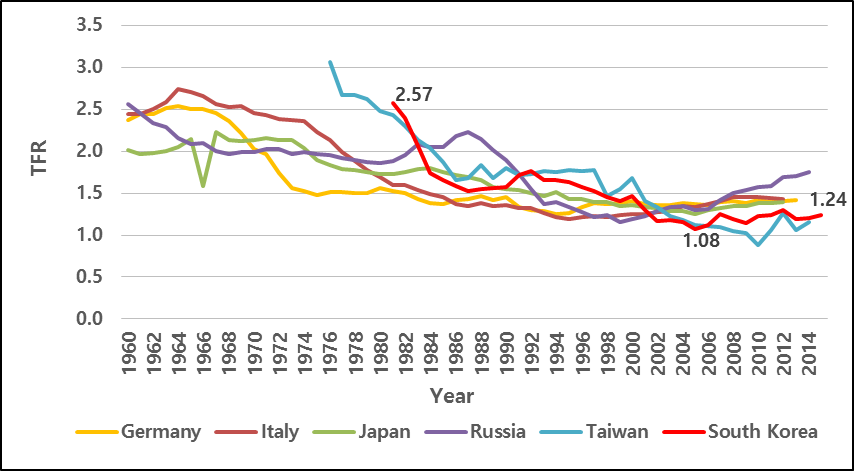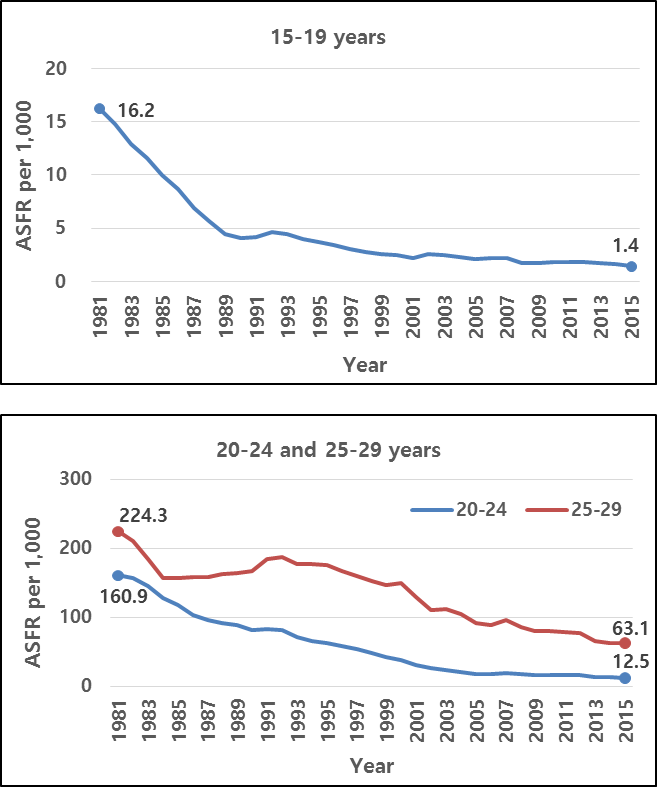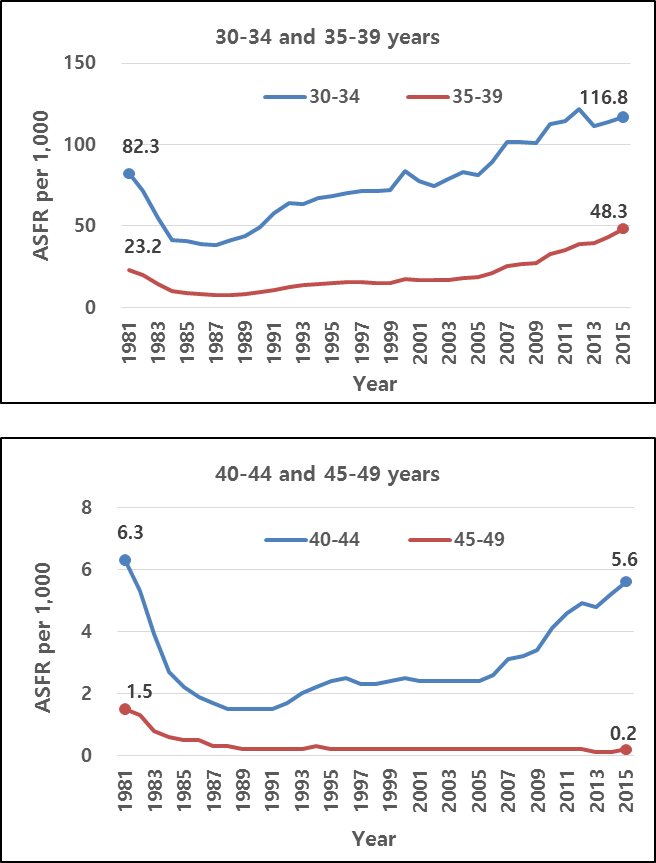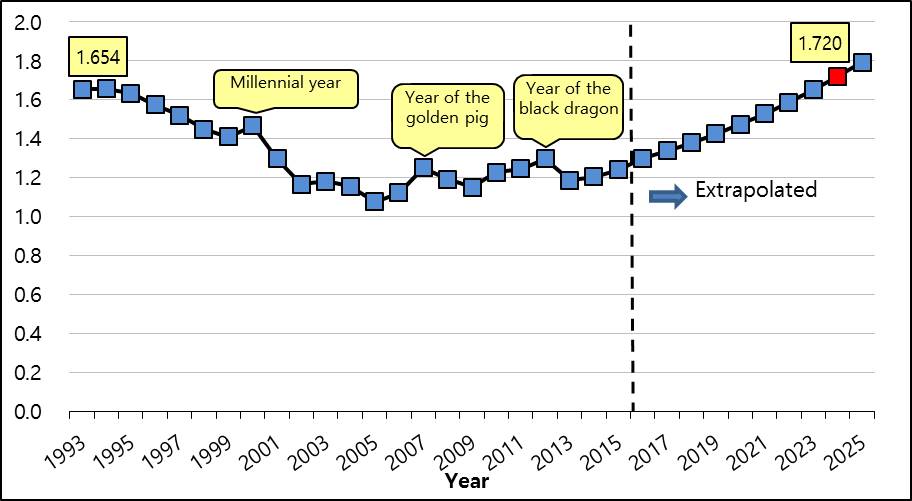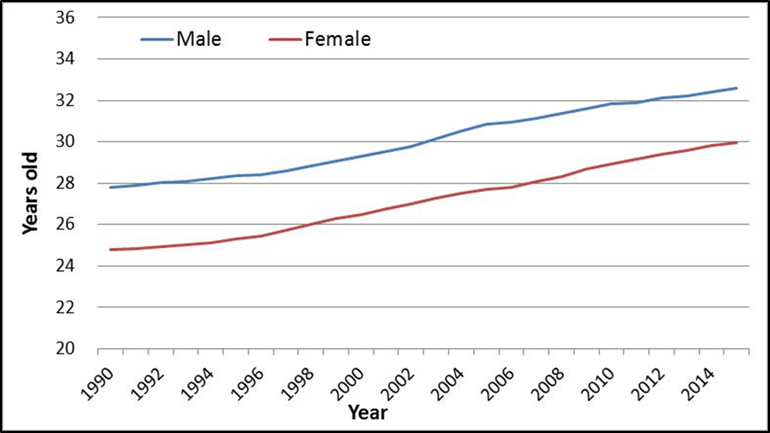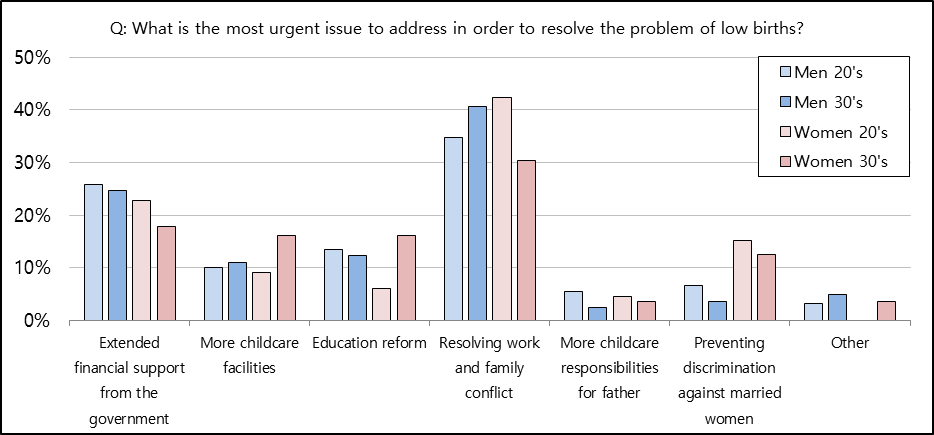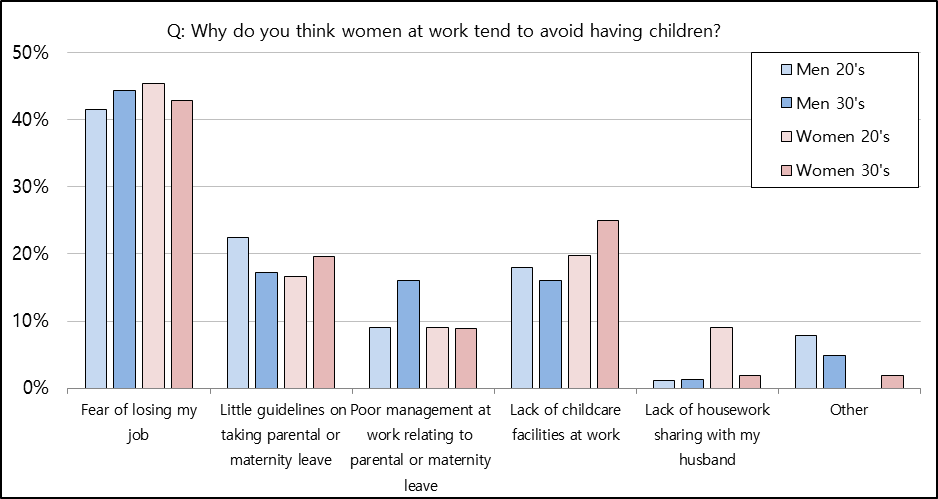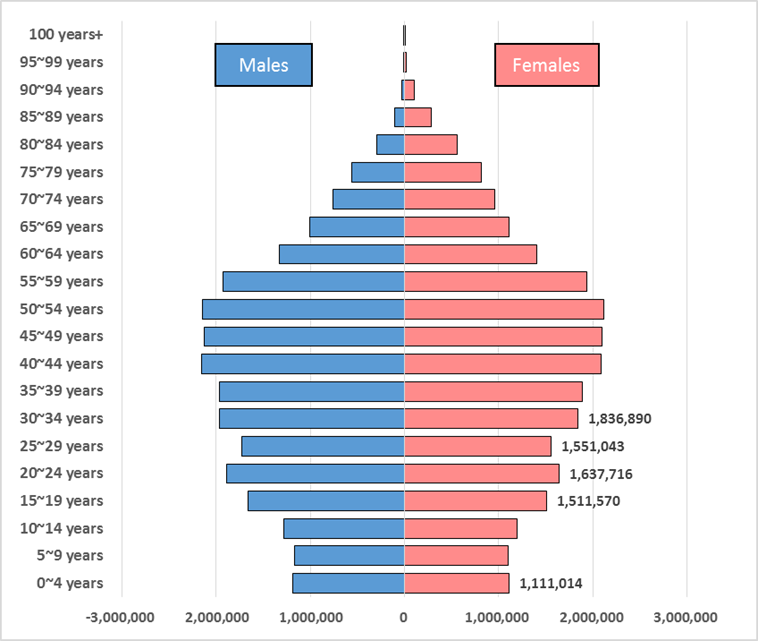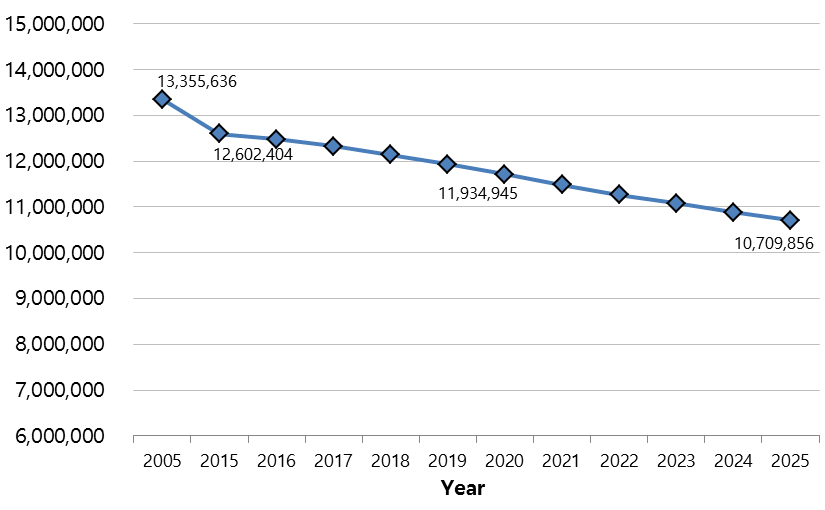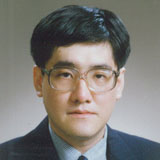Executive Summary
• At present South Korea has one of the lowest levels of fertility in the developed world, even when compared to the low-fertility countries such as Germany, Italy and Japan. Protracted low fertility leads to aging and reduction in the size of the population. Thus, it is a cause of significant concern to the South Korean political establishment.
• Signs of recovery in the total fertility rate in South Korea have been seen since 2005. We maintain that this may be the beginning of the long-term recovery. In order to support the recovery the government needs to gain better understanding of its underlying causes and dynamics.
• The recovery is shown to result from the increase in fertility of women aged 30-39 years. This suggests that the sharp declines in fertility in the previous periods represented the phenomenon of postponement of fertility till later stage in life. This is in line with the developments seen elsewhere in the West. People choose to build families and have children later in life. We suggest that the government efforts to elevate birth rates are directed in a more focused way towards meeting the needs of this group of people.1
• The difficulties and priorities of these people are well known: they perceive family life and work as areas of conflicting demands and fear for job security in the event of having a child. Reduction in work-family conflict, real or imagined, should be the overarching aim of the policy makers. Provision of quality child care, flexible working arrangements and legal protection of parents’ employment rights (especially those of mothers) are specific policy directions to consider.
• South Korean fertility is expected to increase in future years. By 2024 South Korean fertility can be expected to resemble the levels seen today in Canada, Finland and the Netherlands (TFR around 1.7 children per woman). These are not high levels of fertility, to be sure, but they are also not at the currently experienced ‘lowest low’ levels.
What happened to South Korean fertility?
In the decade spanning the early 1990s and the 2000s, South Korea’s fertility crashed reaching, in terms of TFR (Total Fertility Rate), the level of 1.08 children per woman in 2005. That is roughly half of 2.1 needed for population replacement. Perhaps more disturbingly, this is lower than in any other developed country with the lowest levels of fertility, with a single exception of Taiwan (see Fig. 1).
Figure 1: Total fertility rate in South Korea, compared to selected low-fertility countries
The interrelated problems of low birth rates, ageing society and population size in South Korea were first recognized in 2003 under the Roh Moo-Hyun government (2003-2008). To tackle this problem, the Presidential Committee on Ageing Society and Population Policy was set up in 2004. The fact that it was the ‘Presidential Committee’ shows the importance attached to solving this problem, and the first government action plan under the title ‘The First Plan for Ageing Society and Population’4 for the period 2006-2010 appeared in 2006. However, when the next Lee Myung-Bak government (2008-2013) took office, this Committee was put under the control of the Ministry of Health and Welfare rather than directly under Office of President. ‘The Second Plan for Ageing Society and Population’ for the period 2011-2015 appeared in 2011. The government spent 19.7 trillion KRW (17.8 billion USD) and 60.5 trillion KRW (63.4 billion USD) successively over the two five year periods specifically to raise declining birth rates.
The government first action plan contained, for example, financial support for childcare and education, the provision for more schools with after-school education program, infrastructure investment that can deliver quality childcare and better employment terms and conditions for couples taking a maternity and parental leave to spend more time with their newborn baby. During the second plan, these employment terms and conditions were further improved (e.g., being paid 40% of their normal income with the limit set at one million KRW), flexible working practices including shorter working hours were encouraged to balance work and family life. A greater portion of medical expenses for having a baby was met as well as covering the costs of fertility treatment. Financial support for childcare was extended to everyone up to the age of 5 and was no longer means tested. Also, newly married couples would have found easier to get a home loan.
During the 10 year period from 2006 to 2015, the average TFR was 1.21 since hitting the lowest level of 1.07 in 2005. There were two separate peaks, one in 2007, the year of the golden pig when TFR reached 1.25 and the other in 2012, the year of the black dragon, when it reached 1.3. For example, TFR increased by 11% in 2007. Many would-be parents might have held the belief that giving a birth to a baby at these times would bring good luck according to Chinese astrology. The fact that the two peaks coincided with these years leads us to believe that this factor could have made significant contributions to forming the peaks. Table 1 shows increases in TFR and the number of children born in the millennial year, the year of the golden pig and the year of the black dragon compared to the year before (see Fig. 5).
Table 1: Increases in TFR and the number of children born in years 2000 (the millennial year), 2007 (the year of the golden pig) and 2012 (the year of the black dragon)
Following the peaks, TFR slipped back to the level of 1.19 due to the financial and economic crisis (2008) and the economic slowdown (2013). TFR climbed to 1.24 in 2015 but this is still below 1.3 defined to be the threshold level at which a country is experiencing ‘lowest low fertility.’ Ever since the year 2000, the year of the millennium baby with TFR at 1.47, South Korea has been trapped in the prolonged period of ‘lowest low fertility’ despite government action.
On the whole, it looks as though popular beliefs could have had a more visible effect on raising TFR than the government policies. One way to increase the effectiveness of the policies is to target them better – for example, towards the groups most susceptible to these policies. What are these groups in the case of South Korea? In order to identify these groups, we maintain, one needs to understand, in purely demographic terms, how and why South Korean fertility reached such a low level.
Why and how South Korean fertility crashed: the demographic explanation
Total fertility rate is an overall indicator of fertility in a given period of time. However, it is a summary measure reflecting levels of fertility across all age groups. An in depth understanding of fertility dynamics requires examination of fertility trajectories of each age group contributing to TFR. When this is done it becomes clear that dramatic decline in South Korean fertility is, in fact, a responsibility of the youngest age groups in population, as shown in Fig. 2. Since 1981 to 2015 fertility of age groups 15-19 years, 20-24 years, and 25-29 years declined dramatically, with some signs of levelling off in sight but certainly no signs of reversal.
Figure 2: Age-specific fertility rates (ASFR) in South Korea, per 1,000: age groups 15-19 years, 20-24 years, 25-29 years.
The older age groups exhibited a completely different fertility behavior. For all women aged 30-44 years fertility rose significantly starting in the mid-1980s, and, at the time of writing, no signs of levelling off were observed (see Fig. 3).
Figure 3: Age-specific fertility rates (ASFR) in South Korea, per 1,000: age groups 30-34 years, 35-39 years, 40-44 years, and 45-49 years
The picture resembles closely the characteristics of fertility trajectories in the European countries with low fertility. There too the fertility among the young women declined. That, however, signaled the postponement of childbearing to older ages rather than the decision to have less children or no children whatsoever. After all, in many European countries the completed cohort fertility, i.e. the final number of children to women at the very end of their childbearing, did not change significantly between women born in 1955 and those born in 19655. We will return to this issue later in the report. Concomitantly, the peak years of fertility (highest age-specific fertility) shifted from the 20s to the 30s of women’s lifespan. In the course of the first decade of the 21st century total fertility rate in many European countries grew reflecting the high and increasing fertility of women in their 30s. Let us remember that different age groups ‘compete’ for expression in TFR and, whilst the increase in fertility of women in their 30s in Europe had been taking place, the increase in TFR lagged behind as a result of continuing decline in fertility of women in their 20s. In the next sections we show that South Korean fertility is likely to follow its European counterparts’ path and its total fertility can be expected to recover eventually in the future.
The projection: TFR recovery in the second decade of the 21st century
We maintain that the processes that would, eventually, result in recovery at the level of the TFR have been going on for a while and observing their impact on TFR is only a matter of time. Fertility of women in their 30s was on the rise since the early 1990s, only it has not made its impact on the TFR as yet. The situation will change soon. South Korean fertility is on its way to recovery as shown in Fig. 4.
To obtain the insight into the timing and the pace of TFR recovery a projection of age-specific fertility rate for the next decade has been produced. The projection relies on simple extrapolation of the observed trends for ages 25-44 years. It is assumed that fertility for ages 15-24 years will stabilize around the values most recently. For the 45-49 age group, the stability at current values is also assumed.
Those in the 35-39 year age group are expected to have the steepest increase in fertility followed by those in the 30-34 year age group. These age groups will determine the TFR trajectory in the course of the next decade.
Figure 4: Age-specific fertility rates in South Korea (per 1,000): the actual and the projected
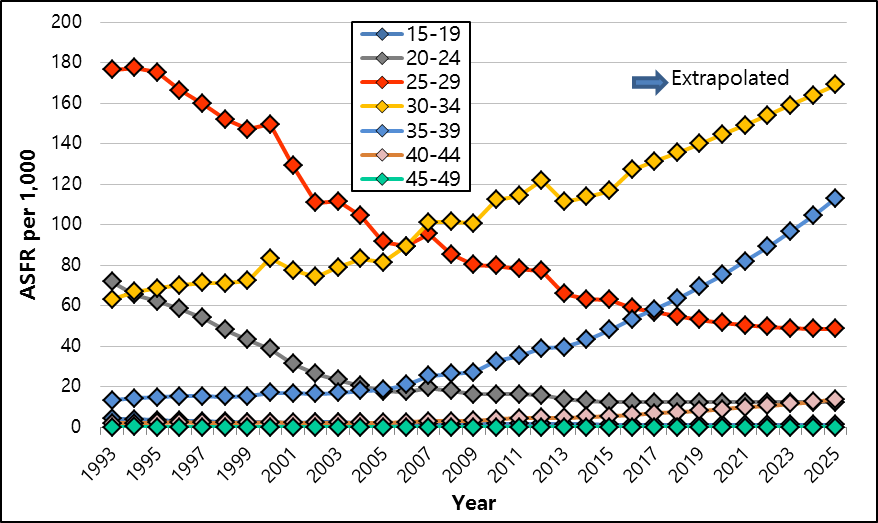
Sources: Korean Statistical Information Service. It is noted that polynomial extrapolation based on data from 1993 to 2015 were carried out to predict the future ASFRs for the age groups between 25 and 44 years with fitted curves all having R2 > 0.9, but other age groups were fixed at 2015 ASFRs.6
Fig. 5 shows an upward trend in TFR over the 10 year period from 2006 to 2015, during which the South Korean government was desperately trying to raise the number of children being born. Using extrapolation of the trend in age-specific fertility rates, it is determined that South Korea is at the tail end of the ‘lowest low fertility’ phase and, by 2024, it is expected to surpass the levels seen in 1993. That would make South Korea’s TFR resemble the levels seen today in Canada, Finland and the Netherlands. Whether or not a projected increase in fertility will be translated into a greater number of births is a different matter to be addressed in the following sections of this paper.
Figure 5: TFR in South Korea (per Woman): the actual and the projected
The meaning of the crash and the recovery in South Korean fertility
We have shown above that the dramatic decline in TFR in South Korea was driven by fertility decline among women in their 20s, whilst the currently observed stabilization and the projected increase will be led by the increasing fertility of women in their 30s. It is important to obtain clarity as to what these developments represent and, in particular, the social forces behind them. The successive governments of South Korea have set, to date, three plans7 focused on increasing fertility. However, the most important question to ask in relation to any government programme aimed at changing fertility is just how well it is targeted and how well it understands the causal mechanisms behind fertility that it purports to change.
The general sense of gloom in front of low and falling fertility in South Korea stems, more often than not, from examination of TFR, a summary measure of fertility, and perhaps drawing out implications a little too far into the future. There has even been a newspaper article saying South Korea as nation will disappear some time in future due to shrinking population. A dramatic fall in TFR in the West and in South Korea indicates, first of all, postponement of fertility: ages 15-19, 20-24 and 25-29 are no longer ages when many people choose to have children. This part of the lifespan is taken by other activities which are conceived as incompatible with starting a family: acquiring education, joining the labour force, exploring the world, and building of a career. These life choices are part of the ‘bigger parcel’ of a modern, diverse and dynamic economy, they do not stand on their own. There are other demographic indicators of postponement of childbearing, but also of marriage, to later stages in life. Mean age at marriage in South Korea increased for females from 25 years in 1990s to 30 years in 2015 as shown in Fig.6.
Figure 6: Mean Age at First Marriage
It is noted that this increasing trend over the years has persisted during economically good times as well as bad times.8 New social and economic realities-responsible for both postponement of marriage and childbearing -cannot be ‘switched off’, and, indeed, it is difficult to see how this can be a reasonable goal for the government or the society as a whole. Rising of fertility maybe a desirable goal but it cannot be achieved through regressive movement in other areas of life.
What should be done, then?
The first step is a realization that people still desire children. How can one be confident that this is the case? Consider the extent of ‘catching up’ with fertility, i.e. the degree to which women of earlier generations resemble the women of younger generation when it comes to the final number of children they have at the very end of their childbearing lives (i.e. around age 49 years). The index describing this final number of children is called completed cohort fertility. On the basis of the available data we estimated completed cohort fertility of South Korean women born in the 1960s and the early 1970s. In Table 2 South Korea is set in comparison to selected European countries.
The final number of children that an average woman of a given generation would have declined only slightly between women born in the late 1960s and those born in the early 1970s. Completed cohort fertility of women in the latter group (1.68 children per woman) was 10.2% lower than fertility of women in the former group (1.87 children per woman). So, 89.8% of fertility of the earlier cohort was recovered in the later cohort. This is somewhat less than, for example, in Austria, Belgium, Germany, Sweden and the UK but more than in Spain.
Table 2: Completed cohort fertility in South Korea and selected European comparators
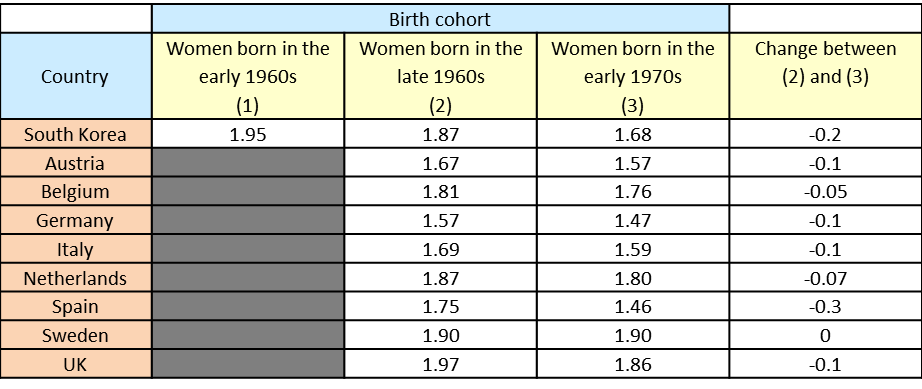
Sources: South Korea: Korean Statistical Information Service. All comparators: Hoorens, S., Clift, J., Staetsky. L., Janta, B., Diepeveen, S., Morgan Jones, M., and Grant. J. 2011. Low fertility in Europe. Is there still reason to worry? RAND Corporation MG-1080, p.9.
Note: The calculation assumes that exposure to possibility of having children starts conventionally at 15 years and comes to an end at 49 years.
Thus, the younger cohort does not catch up completely with the older cohort. However, the levels of fertility of two cohorts of women are rather close, and both are significantly higher than currently observed period TFR levels (around 1.24 children per woman). ‘Catching up’ is taking place, and, although it is partial, those women in the middle of their reproductive ‘careers’ today are not expected to end up with completed cohort fertility as low as 1.24.
So, ‘catching up’ is happening and people still want to have children. Only they would have them when it is more convenient under the contemporary conditions. That means: in their 30s and even early 40s. Judging by the experience of other countries around the globe, this development is inevitable. A well-targeted government programme will take into account the change in timing of fertility, and will be designed in such a way as to help people to carry out their original plans (late fertility) more comfortably.
Women and men in their 30s, mothers with careers constitute the natural target groups for government intervention in South Korea. Attitudes and priorities of these groups are well known. When asked about the most urgent issue to address in order to solve the problem of low births, both men and women chose resolving work-family conflict as a first priority followed by more generous financial support from the government (see Fig. 7).
Figure 7: The most urgent issues to address in order to resolve the problem of low births
When asked about why women at work avoid having children, women aged 20-30 years list, in descending order, fear of losing their jobs, the lack of childcare facilities and guidelines on taking parental or maternity leave (see Fig. 8).
Figure 8: Perceived reasons of avoiding childbearing
Thus, ensuring continuity of employment of the new parents, as well as flexibility of working arrangements for mothers and their spouses and quality and affordability of childcare are the natural directions to pursue. Declaring support of higher fertility in general terms, as governments tend to do, and even lending it some sort of general-purpose budget cannot be expected to help much. To give these policies a realistic chance of success the policy makers need to:
• correctly identify causes of low fertility, in this case: postponement of births in line with the new lifestyle;
• identify the groups that are amenable to intervention because they are already on the path to building a family: women and men in their 30s and 40s;
• focus on the areas deemed most relevant by these groups.
The number of births and the future of population growth in South Korea
The discussion now turns to a different, and often forgotten, topic of the consequences of the increase in fertility. Is the number of births in South Korea expected to rise as a result of the projected increase in fertility? The answer is not as simple as it seems. Intuitively, it appears that an increase in fertility must mean ‘more births’ and more positive population balance. However, there is another demographic regularity at play in determining the number of births, in addition to fertility as such, and that is the number of women of childbearing ages in population. South Korea has experienced falling fertility for a while now and young groups in its population are numerically smaller than the older groups.
Observe the South Korean population pyramid in Figure 9. The base of the pyramid is narrower compared to the middle, which means that the number of parents of the future (and especially, mothers of the future) is projected to be smaller than the number of today’s parents. Consider the following specific example. An age group with the highest fertility in South Korea in 2015 is 30-34 years. In 2015 this age group had 1,836,890 women. However, 5 years later, in 2020, the number of women in this group will be around 1,551,043 (these are women aged 25-29 years in 2015, who will, naturally, form the age group 30-34 years in 2020). When the youngest children will reach age 30-34, around year 2045, there will be just 1,111,014 women in 30-34 years age group. In this example, no allowances have been made for mortality (not very high in South Korea) or migration, but even without these factors the main lesson is clear: contraction of potential mothers is on the cards in South Korea and this may suppress the number of births and population growth even if the number of children per woman increases.9 The described phenomenon is known as ‘population momentum’.
Figure 9: South Korean population pyramid, 2015
The dependence of the number of births on the population structure is often thought of as a ‘trap’. This very feature may counterbalance the gains from the increase in fertility. The policy makers are well advised to take into account the existence of population momentum and adjust their expectations, metaphorically speaking, as to the impact of any policies aimed and increasing fertility. The policies may prove successful and/or fertility may increase for reasons independent of specific policies, but the increase in the number of births is not an arithmetical necessity following from the increase in fertility. To further illustrate this point we present an estimated number of women of childbearing age in years 2005-2025. All figures for years 2015-2025 have been estimated by the Korean statistical authority and allow for mortality and migration. The population of potential mothers in South Korea is declining and in 2025 it is projected to be 19.8% lower than in 2005. There was a nearly 5.6% decline in years 2005-2015.
Figure 10: Estimated number of women aged 15-49 years in South Korea, 2005-2025
Consider the interaction of decline in population of women with increasing fertility. In 2005 there were 13,355,636 estimated women of childbearing age in South Korea. Total fertility rate in 2005 was record low in South Korean history at 1.076 children per woman. In that year estimated 420,812 births took place. A decade later, in 2015, TFR was 15% higher than in 2005: 1.24 children per woman. Yet, the number of births was almost the same: 438,147, about 4% higher than in 2005. This is because the number of women giving birth declined in the meantime and the increase in TFR is not sufficient to counter-balance the effect of that decline. If 2015 fertility levels were applied to the number of women in 2005, the expected number of births in 2015 would be 498,658, an 18.5% increase!
In previous sections we projected fertility forward and have shown that, should the recently observed trends continue, increase in South Korean fertility is very likely. In this section we indicated that decline in the number of potential mothers will take place concomitantly thus dampening the effect of fertility increase. It should not be surprising if the number of births in the next few years remains not very far from the record low number observed in 2005. Thus, in policy terms an investment in encouragement of higher fertility is as important as preparing for the consequences of population aging, an inevitable process ‘written in the body’ of the South Korean population pyramid. The recovery of fertility will help to stabilize population structure but will not prevent increase in proportion of the elderly in the medium term. The effects of the projected increase in fertility on population structure will be fully felt in a few demographic generations time.
Acknowledgements
We would like to thank Mr. Geon-Hee Ham for his help with data collection.
* The views expressed herein do not necessarily reflect the views of the Asan Institute for Policy Studies.
Bibliography
- 1.
In the latest ‘The Third Plan for Ageing Society and Population’ for the period 2016-2020, the government plans to spend 108.4 trillion KRW (96.3 billion USD) on new and existing schemes to raise birth rates between 2016 and 2020. Women in this particular age group and their spouses may prove more responsive to government intervention than other age groups.
- 2.
- 3.
- 4.
http://www.mohw.go.kr/ It is only available in Korean version.
- 5.
Hoorens, S., Clift, J., Staetsky. L., Janta, B., Diepeveen, S., Morgan Jones, M., and Grant. J. 2011. Low fertility in Europe. Is there still reason to worry? RAND Corporation MG-1080, p.9.
- 6.
We hypothesize that increasing fertility will eventually stabilize around TFR of 2.0, in accordance with the expectation based on the demographic transition theory. It remains to be seen if TFR will indeed follow the steep slope of the projected curve. What is important here is that ASFRs in the 30-39 age group are likely to increase in the coming years. On a related issue, there are many factors that determine fertility rates. These include, for example, the level of education, the availability of birth control and the cost of raising and educating children and many others.
- 7.
The previous plans laid down the groundwork to take on the problem of low birth rates and succeeded in stopping the further decline of TFR. But these plans were limited in scope and too focused on helping parents in monetary terms. In the latest government’s third plan, the government is taking on more difficult challenges of transforming people’s pervading social attitudes and perceptions which have exacerbated the problem of low birth rates. For example, many unmarried single mothers experience prejudice and discrimination and the abortion rate in this group is very high. How effectively the government can transform people’s attitudes towards them and thus take a step closer to achieving its policy goal remains to be seen.
- 8.
This lends little support to the idea that economically good times (e.g., early 1990’s and 2000’s) would reduce the mean age at first marriage and this, in turn, would increase the ASFRs in the 20-24 and 25-29 year age groups.
- 9.
Back in the 1970s and 1980s, South Korea put in place policy to lower the number of births. This policy was discontinued in 1996.

 Facebook
Facebook Twitter
Twitter